Commonwealth Ombudsman Annual Report 2003-04 | Chapter 3
![]()
CHAPTER 3 | performance report
Introduction
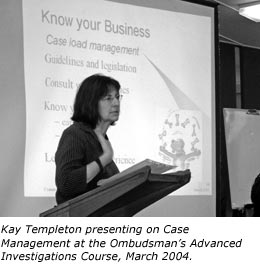 This chapter of the report details performance relating to the resources appropriated to the Ombudsman
by the Australian Government and agreed outcome and outputs.
This chapter of the report details performance relating to the resources appropriated to the Ombudsman
by the Australian Government and agreed outcome and outputs.
The performance framework summarised in the summary table of outcome and output achievements does not cover all of the office's diverse range of activities. A summary of achievements follows the performance table to provide a context for the office's formal reporting requirements.
The role of the Commonwealth Ombudsman is principally performed under the following legislation.
Ombudsman Act 1976 (Cth)
The Commonwealth Ombudsman can consider complaints about almost all Commonwealth agencies and some contractors delivering government services to the community. Under this Act, the Commonwealth Ombudsman is also the Defence Force Ombudsman and is empowered to deal with complaints by serving or former members of the Australian Defence Force, and is the Taxation Ombudsman in relation to complaints about the Australian Taxation Office (ATO).
Complaints (Australian Federal Police) Act 1981 (Cth)
The Ombudsman has a role in the handling and investigation of complaints against the Australian Federal Police (AFP), in their national and ACT policing roles.
Ombudsman Act 1989 (ACT)
The Commonwealth Ombudsman is the ACT Ombudsman in accordance with a Memorandum of Understanding between the Ombudsman and the ACT Government.
Complaints received and finalised about ACT Government departments and agencies are included in the Ombudsman's overall complaint-handling numbers. The Ombudsman has provided more detail on the performance of the ACT Ombudsman function in the ACT Ombudsman 2003–04 Annual Report to the ACT Legislative Assembly. The annual report is available at www.ombudsman.act.gov.au.
Performance at a Glance
Summary table of outcome and output achievements
Outcome Achieve equitable outcomes for complaints from the public and foster improved and fair administration by Australian Government agencies.
| Budgeted price of outputs | $10.295m |
| Actual price of outputs | $10.520m |
| Budgeted Departmental appropriations | $9.376m |
| Actual Departmental appropriations | $9.462m |
| Budgeted revenue from other sources | $0.919m |
| Actual revenue from other sources | $1.058m |
OUTPUT 1 Provision of a complaint management service for government
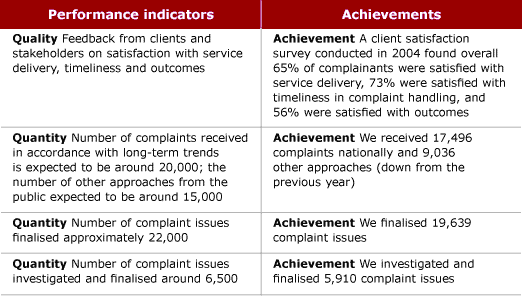
OUTPUT 2 Provision of advice to government to improve public administration

Full details of the total price of agency outputs of the Ombudsman's office are detailed in Note 20 of the Financial Statements.
Output 1 Provision of a complaint management service for government
Output 1.1 Feedback
Performance indicator Feedback from clients and stakeholders on satisfaction with service delivery, timeliness and outcomes
Satisfaction
In May 2004 we commissioned a market research company to conduct a Client Satisfaction Survey of 2,000 complainants across all jurisdictions of the Ombudsman's office. The survey found that the majority of complainants were satisfied with the service they received from the Ombudsman's office. Where the office investigated complaints, some 65% of complainants were satisfied that staff had done as much as they should have to help. Of complainants referred by staff to the relevant agency in the first instance, 74% said they would consider using the Ombudsman's office for future complaints. A large majority (87%) of complainants who were advised to take up their complaint directly with the agency followed our advice.
These satisfaction rates reflect the fact that people using our services are, by definition, already dissatisfied before approaching our office. Other factors can also affect satisfaction levels. For example, some people with an easily resolved complaint are advised that they should first contact the agency. Any misapprehension about the Ombudsman's role has an impact on evaluation of the office.
While the overall results were pleasing, the survey highlighted a number of areas where we can make improvements to our services and training programs to address areas of weakness and to improve consistency. In the coming year we will expand our training programs to include mediation and alternative dispute resolution, dealing with difficult people, and management skills. In addition, we aim to provide more information to people about agencies' internal complaint-handling areas via our website and publications. This will enable complainants to deal with agencies directly in the first instance, leaving Ombudsman staff to deal with the more complex complaints.
Timeliness in complaint handling
In 2003–04, 83% of all complaints were finalised within one month of receipt—consistent with previous years and marginally below the target of 85% for the year.
The proportion of investigated complaints finalised within one month was 69%, slightly better than last year (65%).
Data from our complaints management system is used to monitor response times and to identify delays. With many of the complaints we investigate, we need to factor in the time it takes for agencies to provide us with information. Quality assurance reviews are conducted for 75% of complaints. Monthly statistical reports enable senior management to monitor current issues and trends.
Timeliness in the handling of complaints about the AFP has remained satisfactory this year. The different complaint-handling procedure established by the Complaints Act means that the majority of investigations and conciliations of complaints are first conducted by AFP Professional Standards, followed with a review by the Ombudsman's office. This is necessarily a longer process than for the handling of general complaints, but it is pleasing to note that this year the office finalised over 89% of all AFP complaints within six months of receipt.
The Ombudsman has reported in detail about timeliness in the handling of complaints about ACT agencies in a separate report as ACT Ombudsman. This report is available at www.ombudsman.act.gov.au. Figure 3.1 shows the time taken to finalise complaints under the three Acts in 2003–04.
FIGURE 3.1 Time to finalise complaints, by Act, 2003–04
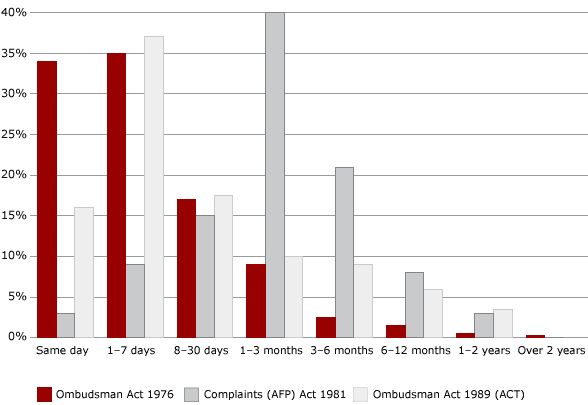
Remedies
In 2003–04, as in previous years, the most common remedy for complaints was the provision of a detailed explanation by an agency of its decision or action. This was particularly the case in complaints about police, and reflected the ongoing commitment of the AFP to conciliation of less serious matters. A remedy was provided in 26% of complaints finalised. A breakdown of remedies by Act is provided in Table 3.1.
TABLE 3.1 Remedies provided by Act, 2003–04
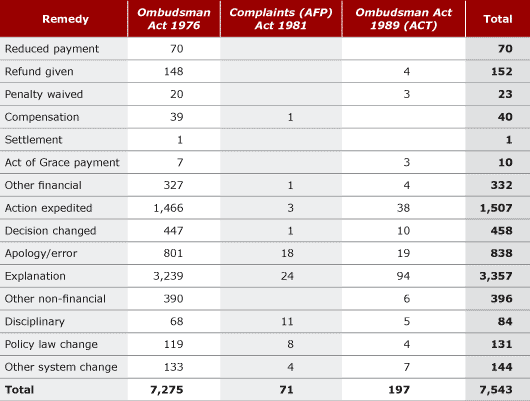
Service quality
We use both positive and negative feedback from complainants to improve our services and identify areas needing improvement. We also apply the same principles to our own operations that we espouse for other Commonwealth agencies: specifically, there should be a clear-cut procedure by which a person who is not satisfied with the way in which an investigation has been handled can seek an internal review of the matter.
The internal review process offered to complainants is set out in the Commonwealth Ombudsman's Client Service Charter. A more senior officer who was not directly involved in handling the original complaint always carries out internal reviews.
In 2003–04, the office received 107 requests for review, a 23% decrease on the number of similar requests received last year. The total figure is less than 1% of total complaints finalised. Table 3.2 sets out the reasons expressed by complainants who sought review during the year.
TABLE 3.2 Requests for internal review of Ombudsman action, 2003–04
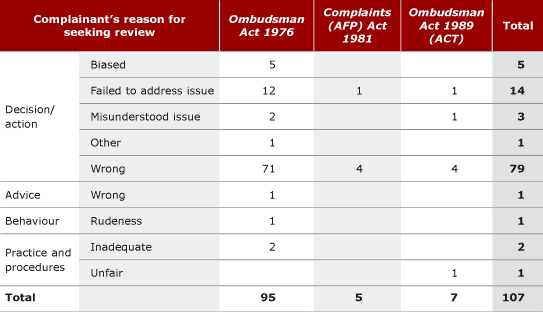
Of the 107 review requests received, 95% related to decisions or actions of the office on complaint investigations. The main reasons expressed by complainants for seeking a review were wrong decision/action or advice, failure to address issue or biased decision.
During the year, 102 reviews were finalised, including 23 review requests received before 30 June 2004. Of those reviews finalised, the original outcome was affirmed in 88 reviews (or almost 86% of reviews). The office agreed to conduct additional investigation in eight reviews. Of the six reviews remaining, one complaint was found to be substantiated and corrective action taken, two were found to be unsubstantiated, and in three reviews the office agreed to change its decision on the original complaint. These review outcomes are summarised in Table 3.3.
TABLE 3.3 Decisions by Ombudsman’s office on internal review, 2003–04
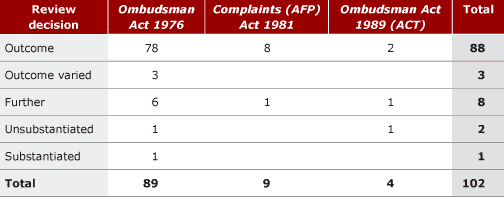
Note: Of the 102 reviews finalised in 2003–04, 23 requests were from the previous year.
Output 1.2 Complaints received
Performance indicator number of complaints received in accordance with long-term trends is expected to be around 20,000; the number of other approaches from the public expected to be around 15,000.
During 2003–04, we received a total of 17,496 complaints, a decrease of 12% on the previous year. This decrease in total complaints received is against the trend over the past few years, in which the number of complaints received has been fairly stable. There has, however, been a steady increase in the number of more complex matters and in complaints raising systemic issues, as detailed in the agency-specific chapters of this report.
'Other approaches' refers to contact by members of the public with the Ombudsman's office that is not recorded as a complaint, such as out-of-jurisdiction matters and requests for information. There was a fall of 19% to 9,036 in 'other approaches' to the office in 2003–04 compared with the previous year and a fall of 40% against the estimated performance indicator of 15,000. This decrease is in line with that for complaints received.
The decrease in total complaints received in 2003–04 was experienced in most areas. There were significant decreases in complaints received about the Department of Immigration and Multicultural and Indigenous Affairs (down 23%), the Child Support Agency (down 20%), Centrelink (down 16%) and the ATO (down 10%), and a slight decrease in complaints received about the AFP (3%).
This decrease was offset by an increase in complaints about the Department of Transport and Regional Services (up 112%) and the Department of Employment and Workplace Relations (up 20%).
The decrease in the total number of complaints received during 2003–04 may reflect the effort some of the larger departments and agencies have put into improving internal complaint-handling processes. This may also explain the increasing average complexity of complaints being handled by the Ombudsman's office and the length of time required to investigate and finalise complaints (as more of the simple complaints are handled by the agencies).
There was an increase of 19% in the number of complaints lodged electronically, with 1,020 complaints being received by this method, and a fall of 19% in the number of complaints lodged in person. Opportunities for better collection of electronic complaints will be evaluated in 2004–05 when the office's website is redeveloped.
3.5 detail complaints and approaches received in 2003–04 by Acts and office receiving and complaints received by method received.
TABLE 3.4 Complaints and approaches received, 2003–04
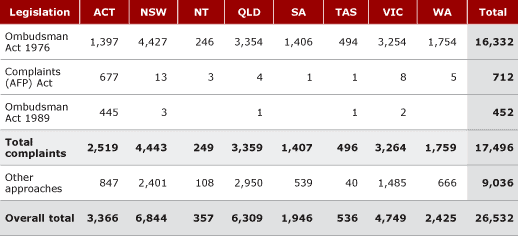
TABLE 3.5 Method of receipt, 2003–04
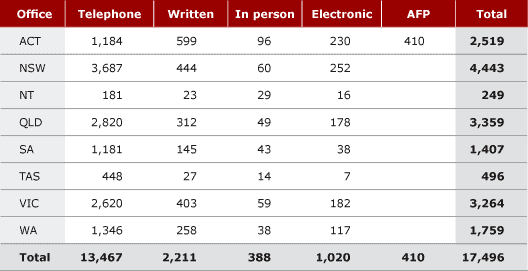
National complaints line
During the year, the office received a total of 27,160 telephone calls to its 1300 national complaints number. This equates to an average of 109 calls per day. On average, 58% of calls were from regional areas of Australia, 38% from inside the metropolitan zones and the remaining 4% from mobile phones. Table 3.6 provides detail.
TABLE 3.6 Calls received through national complaints line, 2003–04

Complaints by agency
In 2003–04, complaints about Centrelink, the ATO and the Child Support Agency accounted for 67% (11,746 complaints) of the total number of complaints received, down 3% from last year.
There was a decrease of 10% in complaints received about the ATO, as mentioned. This is the fourth consecutive year that complaint numbers about the ATO have fallen, reflecting the 'bedding down' of the new tax system and also the settlement opportunity for mass-marketed scheme investors. These factors are discussed in more detail in Chapter 5 of this report.
The total number of complaints about the Department of Immigration and Multicultural and Indigenous Affairs fell by 23% compared to the previous year.
The number of complaints received about Australia Post was in line with the previous year: 1,079 in 2003–04 compared to 1,082 in 2002–03.
Charts comparing complaint trends over the past five years for those agencies against which the most complaints to the Ombudsman are made are included in Chapter 5.
Output 1.3 Complaints finalised
Performance indicator Number of complaint issues finalised approximately 22,000.
This year, the Ombudsman's office finalised 17,418 complaints nationally, compared to 19,964 in 2002–03 (a 13% decrease).
Complaints made to the Ombudsman often include more than one issue. For example, a complainant may allege that a decision was not only wrong substantively, but also that the agency failed to provide accurate advice, was unreasonably slow, or that client service staff of the agency displayed an inappropriate attitude. Similarly, different issues within the same complaint may result in different actions by the Ombudsman's office. In the example above, the office may suggest that the complainant pursue internal review mechanisms with respect to the agency's substantive decision, but may investigate the issues around delay and service delivery. It is for this reason that the Ombudsman's office reports also on complainant issues finalised by the office.
In 2003–04, 19,639 issues were finalised, arising from the 17,418 complaints finalised. Of these 19,639 issues, the Ombudsman's office investigated 30%, compared to 29% of complaint issues investigated in the previous year. The remaining 70% of complaint issues were usually finalised by the complainant being advised to raise the issue with the agency, or by a finding that investigation of the complaint was not warranted.
Output 1.4 Complaints investigated
Performance indicator Number of complaint issues investigated and finalised around 6,500.
Of the complaint issues investigated and finalised, some agency error or deficiency was identified in 20% of complaints (compared to 29% in 2002–03). No error or deficiency was identified in 43% of instances (compared to 42% last year). In the remaining 37% of issues investigated, complaints were resolved without the need to determine whether or not the cause of the problem had been defective administration, and no determination about the agency's performance was made. Further details of investigation outcomes may be found in the 'Statistics' chapter at the end of this report.
Causes of complaint
Following an established trend, the majority of the complaint issues finalised this year by the Ombudsman's office under the Ombudsman Act 1976 related to the correctness or propriety of a decision or action of an agency. The remainder of the complaint issues finalised were about procedural matters, such as timeliness of agency action, or the accuracy or completeness of advice given by agencies. This is similar to the trend over the past three years.
There is a different pattern in the complaints about the AFP (see Figure 3.2). Of the complaint issues finalised this year, 41% arose from the conduct of AFP members, including complaints about attitude, assault and incivility. A further 31% arose from police decisions or actions.
FIGURE 3.2 Cause of complaint (including FOI) by Act, 2003–04
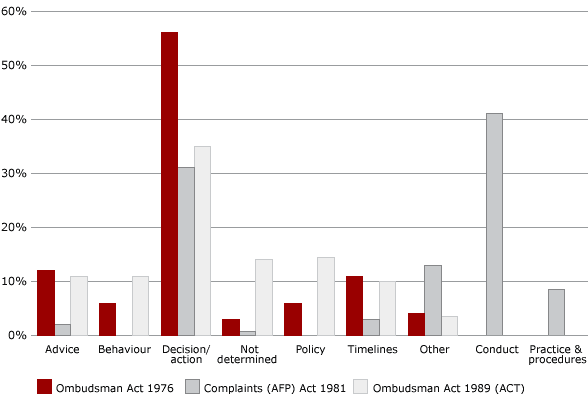
Note: Complaints (AFP) Act 1981—'Other' includes actions of the AFP concerning disclosure of information, property, and use of vehicles and weapons.
Decisions not to investigate
In order to understand the outcomes of complaints, it is necessary to outline the discretionary powers available to the Ombudsman.
The legislation administered by the Ombudsman confers upon the office a range of discretionary powers to decline to investigate matters in particular circumstances. For example, the Ombudsman can decline to investigate if a matter is more than 12 months old; if the complainant does not have a sufficient interest in the subject matter of the complaint; if a complainant has not first raised the complaint with the agency; or if there is a more appropriate alternative avenue of review available to the complainant.
In a practical sense, the most important of these powers is the discretion to decide not to investigate until a complainant has first raised the complaint with the agency. The rationale for deciding not to investigate is that matters in dispute should first be raised and clarified at the source of the problem. In 2003–04, 43% of issues raised in complaints to the Ombudsman were dealt with in this way.
Complaints carried forward
The total number of complaints carried forward was 1,207 at 30 June 2004, compared to 1,085 at the end of the reporting period in the previous year, an increase of 11%. This increased backlog can generally be attributed to the complexity of the complaints and the correspondingly longer period of time required to investigate those complaints.
Output 2 Provision of advice to government to improve public administration
Output 2.1 Improvements to government administration and recommendations implemented
Performance indicator Assessment of improvement to government administration, including feedback from departments and agencies on the value of advice received from the Ombudsman and the extent to which Ombudsman recommendations have been implemented.
The Ombudsman has discretionary power to decline to investigate a complaint, unless it has first been raised with the agency concerned. This has sometimes been perceived as defining the Ombudsman as 'the office of last resort', but that is not an accurate description. Even where a person contacts the Ombudsman as a first point of complaint, the policy of the office is to provide guidance and some assistance to the person on how and where best to pursue the complaint in the first instance. Sample studies have been undertaken in the past to gauge the effectiveness of this referral activity, and more targeted work of this kind will be conducted in 2004–05. A Client Satisfaction Survey conducted in May 2004 showed that the large majority (87%) of complainants who were advised to take up their complaint directly with the agency followed our advice.
The Ombudsman's office recognises that if a complainant is to be referred back to an agency, it is vital that the agency has an effective internal complaint-handling mechanism in place. Each year the office gives a high priority to monitoring agency complaint handling and to working closely with agencies to assist them to improve their internal complaint-handling procedures. This year we conducted reviews into the complaint-handling mechanisms employed by the Department of Employment and Workplace Relations (relating to the Job Network) and the Department of Transport and Regional Services (DOTARS). The review of DOTARS' complaint-handling mechanisms will be finalised in 2004–05.
The notion that complaint handling should first be addressed by the agency concerned is also recognised in other formal ways in the legislation establishing the Commonwealth Ombudsman. Examples are complaints about the AFP, which are ordinarily investigated in the first instance by AFP Professional Standards; and complaints in the Defence jurisdiction, which must first be pursued through the formal redress of grievance processes under the Defence Act 1903, other than in exceptional circumstances.
In summary, most of the investigation work of the Ombudsman's office occurs in three areas:
- where there is no alternative avenue of resolution available to a person, because of either their circumstances or those of the particular complaint
- where there is an indication of a systemic problem in government administration, likely to affect a number of people
- where a complainant remains dissatisfied with the outcome of their treatment, despite a review having already been undertaken by an agency.
Output 2.2 Formal recommendations arising from investigations
Performance indicator The number of formal recommendations made to departments and agencies aimed at improving administration and service delivery, which arise from reports of own motion and systemic investigations.
During the year, the Ombudsman released reports on four own motion investigations; two of the investigations were completed and provided to the agency in 2002–03, and were reported in last year's annual report. These reports are available at www.ombudsman.gov.au. Several own motion investigations are currently being conducted and are due to be completed in early 2004–05.
Of the two own motion investigations conducted and finalised in 2003–04, all of the 15 recommendations in the investigation reports were accepted by agencies.
The Ombudsman's own motion investigation reports released in 2003–04 comprised:
- July 2003—Australian Taxation Office complaint handling
- August 2003—Department of Employment and Workplace Relations, complaints handling in the Job Network
- May 2004—Child Support Agency change of assessment decisions made on the basis of parents' income, earning capacity, property and financial resources
- June 2004—Australian Crime Commission investigation into a review of the operational and corporate implications for the Australian Crime Commission arising from alleged criminal activity by two former secondees.
The high incidence of departments and agencies accepting Ombudsman recommendations for systemic and administrative improvements suggests a highly satisfactory level of performance in identifying opportunities for improvement in administrative practices and procedures during 2003–04.
Under powers conferred by the Complaints Act, Ombudsman staff worked on four special investigations relating to the AFP. Three of these investigations focused on conduct rather than administrative or service delivery issues. The other related to an investigation of certain aspects of the AFP's administration of the National Witness Protection Program that had come under criticism in a matter before a court. Two of these investigations will be completed in 2004–05.
Output 2.3 Feedback on auditing and monitoring activities
Performance indicator Feedback from relevant Ministers and the Commonwealth Parliament on the relevance and utility of Ombudsman reports on auditing and monitoring activities related to law enforcement.
Throughout the year, the Ombudsman provided reports to the Attorney-General under the Telecommunications (Interception) Act 1979 (the TI Act) and to the Minister for Justice and Customs in relation to inspections undertaken in accordance with the Crimes Act 1914. A report of our activities in inspecting controlled operations was tabled in Parliament. Feedback from the Attorney-General has indicated his satisfaction with the performance of the office.
The AFP and ACC regularly consult and liaise with Ombudsman staff on issues such as training and development, current and emerging issues, and our expectations of their staff concerning the administration of telecommunications interception warrants. This demonstrates the growing maturity of our relationship with these agencies.
Ombudsman staff also met with representatives from the Security Law Branch of the Attorney-General's Department during the year to discuss matters relating to the interpretation of the TI Act and to provide comments on proposed policy changes to the Act.
Output 2.4 Audits of telecommunications intercept records
Performance indicator Completion of at least two audits of telecommunications intercept records each year and provision of a timely and complete report to the Minister.
In 2003–04, a total of four inspections of telecommunications intercept records were conducted. Two inspections were conducted at the AFP and two inspections at the ACC. A report was made to the Attorney-General on the results of those inspections. The reports concluded that the agencies are generally complying with the requirements of the TI Act.
These inspections continue to form a core element of the work of the Ombudsman's Law Enforcement Team. The inspection methodology used and resource levels required are regularly reviewed to ensure that the accountability role of the office continues to be met.
Output 2.5: Inspection of controlled operations records
Performance indicator Quarterly inspection of law enforcement agency controlled operations records and provision of timely and comprehensive report to the Parliament.
During the year, a total of four inspections of controlled operations records were conducted. Two inspections were conducted at the AFP and two inspections at the ACC. These inspections resulted in reports to both agencies and the Minister for Customs and Justice, a briefing to the Parliamentary Joint Committee on the ACC, and the presentation of a report to the Speaker of the House of Representatives and the President of the Senate in January 2004. The reports concluded that the agencies are generally complying with the requirements of the Crimes Act and generally providing comprehensive and accurate information in formal reports.
Following the Ombudsman's briefing to the Parliamentary Joint Committee on the ACC in October 2003, an own motion investigation was commenced under the Ombudsman Act 1976 into controlled operations carried out by the ACC under State and/or Territory legislation. The investigation is due to be completed in 2004–05
